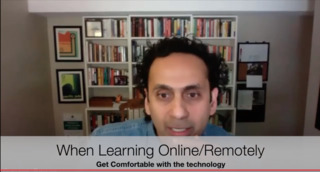Attention
Studying Through the Pandemic: Tips From Cognitive Science
What do the experts say regarding studying during COVID?
Posted August 31, 2020

It's time for school and college again. This academic year is getting off to a very different start with most colleges starting remote classes and a few starting in person.
Regardless of the modality, this is the prime time for students to start strong and establish some studying patterns that can help them succeed. I recently had the opportunity to talk to cognitive scientist Dr. John Dunlosky from Kent State University. Dr. Dunlosky does research on how students study, and he is the lead author of one of the most-cited research articles on effective ways to study. In this piece, I highlight some of the key tips we share, as well as some important studying practices for the pandemic.
In a comprehensive review, Dunlosky et al. (2013) assessed the utility of 10 major study techniques from cognitive and educational psychology. The report drew attention to the main types of techniques that students used to learn. Collapsing results from different courses and studies, the authors created a utility score based on each technique's effectiveness, generalizability across different contexts, and the educational contexts it can be used in. Many commonly used student techniques—review, summarization, highlighting, keyword mnemonic, imagery use for text learning, and rereading—were designated low-utility study techniques. Key: Highlighting and rereading are not a great use of your time, students.

Three techniques—elaborative interrogation, self-explanation, and interleaved practice—were noted to be of moderate utility. When students utilize elaborative interrogation, they aim to explain why concepts are the way they are or why they are true. Self-explanation is where the student explains the link between both new and current knowledge, and self-explanation can also be used to explain the needed steps in a problem. Interleaved practice is a strategy where the student studies different concepts in one sitting. Key: These strategies, if done well, can be useful for learning.
The two learning strategies deemed to be of high utility were retrieval practice and distributed or spaced practice. With distributed practice, studying is spaced out over time instead of crammed together. Retrieval practice, also called practice testing or self-testing, involves the student repeatedly testing themselves on what they know. Similar to spaced studying, practice testing is also significantly related to course grades and exam scores. Dr. Dunlosky unpacks both these practices in our conversation.
During the pandemic, with a lot of classes being remote, there is a key tip: Treat your remote classes as if they were face to face and take good notes. In studies of online learning and remote learning during Spring 2020, the students who struggled were those who did not take notes. They listened to recorded lectures or even took part in live, synchronous lectures, but they did not write anything down.
Taking notes is more than just recording information to study for a test. It is also a means to organize material in your head, see what you did not understand, and help you keep track of what you are learning. If you do not have a good way to take notes, explore different styles, such as the Cornell method, but at the core, use headings, separate main topics, and leave space so that it is easier to chunk the material and study it as you go.
Learning can be a difficult concept to measure because not everyone learns the same way, and numerous factors are associated with students’ academic performance. This is made even more difficult during a pandemic where there are additional stressors and impediments along the way. Spaced practice and practice retrieval are two key ways to go. Taking good notes goes a long way as well.
All the best for a great academic year!
References
Watch the whole conversation here or listen to the podcast here.
Dunlosky, J., Rawson, K. A., Marsh, E. J., Nathan, M. J., & Willingham, D. T. (2013). Improving students’ learning with effective learning techniques: Promising directions from cognitive and educational psychology. Psychological Science in the Public Interest, 14, 4–58. http://doi.org/10.1177/1529100612453266
Gurung, R. A. R. (2005). How do students really study (and does it matter)? Teaching of Psychology, 32(4), 239–241.


